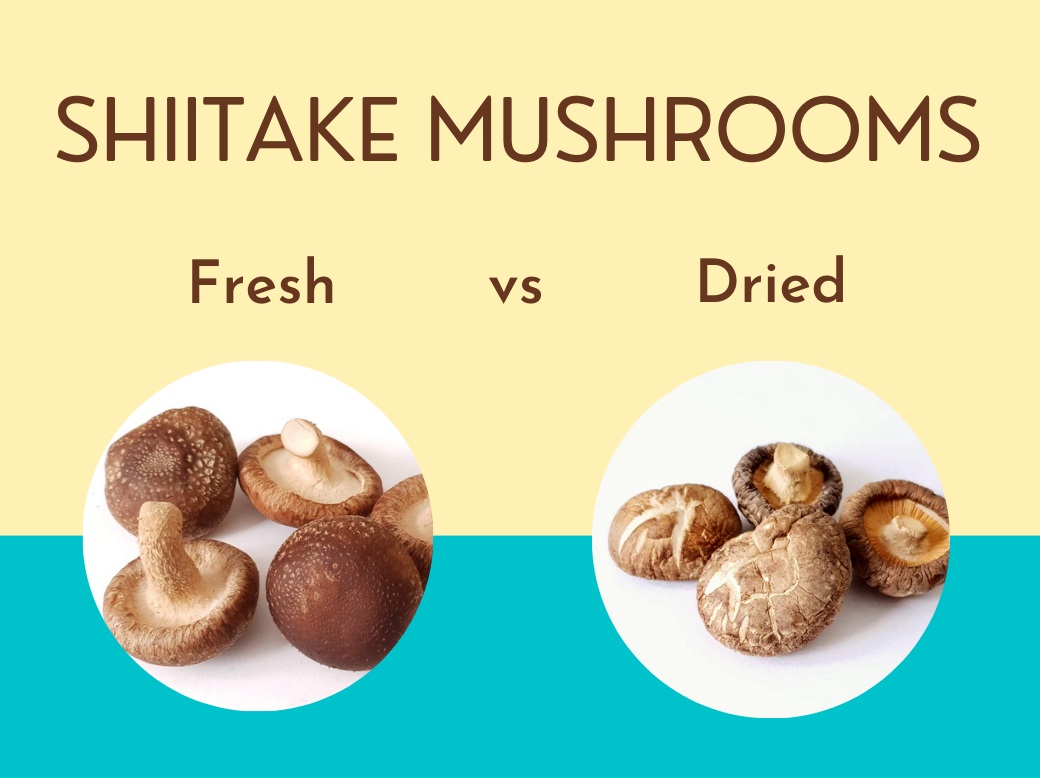Last updated: March 31, 2021

Are fresh Shiitake mushrooms better than the dried ones? Can one substitute the other? In this post, let’s look at the characteristics of both fresh and dried Shiitake which make each of them uniquely suitable for different types of cooking.
What’s the difference
- Smell: If you sniff them, you will find that fresh Shiitake mushrooms have no apparent smell at all, while dried Shiitake are defined by their strong earthy aroma.
Dried Shiitake isn’t just fresh Shiitake minus water. The stronger flavor, highly valued in Chinese and Japanese cooking, is the result of additional umami components formed during drying process [1](reference below for those interested in further reading). - Taste: When cooked, fresh shiitake have a light but exquisite umami taste on the tongue, while rehydrated (dried) Shiitake have a deeper and earthier umami taste. The difference is subtle, but noticeable.
- Texture: Fresh Shiitake have a tender texture, while rehydrated Shiitake may have a slightly more chewy texture than fresh ones, although with sufficient rehydration, the difference in textures will be quite small. Both fresh and rehydrated Shiitake have a succulent texture that holds extremely well during cooking (unlike some other fresh mushroom that shrink a lot during cooking unless special cares are taken).
- Price (per mushroom): In general, but not always, dried Shiitake are cheaper than fresh ones since fresh ones are highly perishable while dried Shiitake is much easier to transport and store.
Fresh Shiitake Are Best for Sautéing and Frying
- I love fresh Shiitake for their unique taste and texture, particularly when eating them whole or in large chunks like sautéing and frying, where the Shiitake mushrooms are themselves the stars, not a condiment to a different main ingredient.
- I also like to use them when steaming (including stuffed Shiitake), especially with seafood which doesn’t need to borrow any umami flavor from the Shiitake mushrooms, and I am enjoying Shiitake as they are.
Dried Shiitake Mushrooms Are Great for Stir-fries, Stews, Soups and More
- Dried (then rehydrated) Shiitake are a potent umami flavor booster. Mere few rehydrated Shiitake mushrooms and the soaking liquid can bring a rich umami taste to a large amount of otherwise mostly bland vegetables (and other plant foods). Dried Shiitake mushrooms are used in Chinese and Japanese cooking to substitute animal produce (which are also rich in umami taste but were often unavailable or unaffordable until the recent decades).
- I prefer dried Shiitake mushrooms for stir-fries, stews, soups, steamed dishes, and buns and dumpling fillings where a great deal of mixing of various ingredients during cooking allows Shiitake mushrooms to impart their aroma to other ingredients. The Shiitake are normally finely chopped or sliced for these cooking methods, allowing further rehydration during cooking and making them very tender too.
When to Substitute
- As you can see from above, fresh Shiitake and reconstituted Shiitake are each unique in their own way. However, when you only have access to one not the other, go ahead and substitute! It is much better to use one of them than leaving Shiitake out of a recipe that calls for it. Cookbooks are full of such examples, it’s not complicated.
Final Recommendation
My final recommendation is eat both and eat them regularly. One can’t truly appreciate Shiitake mushrooms without trying both the fresh and dried versions. The flavor alone is divine, and you can find plenty references on the Internet on Shiitake mushrooms’ healthy benefits too (we’ll leave that to another post). What are your preferences regarding fresh vs dried Shiitake?
Reference:
1. Yang, X., Zhang Y., Kong, Y., Zhao, J., Sun, Y., Huang, M.Q., Comparative analysis of taste compounds in shiitake mushrooms processed by hot-air drying and freeze drying. International Journal of Food Properties, 2019, 22(1):1100-1111 DOI:10.1080/10942912.2019.1628777
Leave a Reply